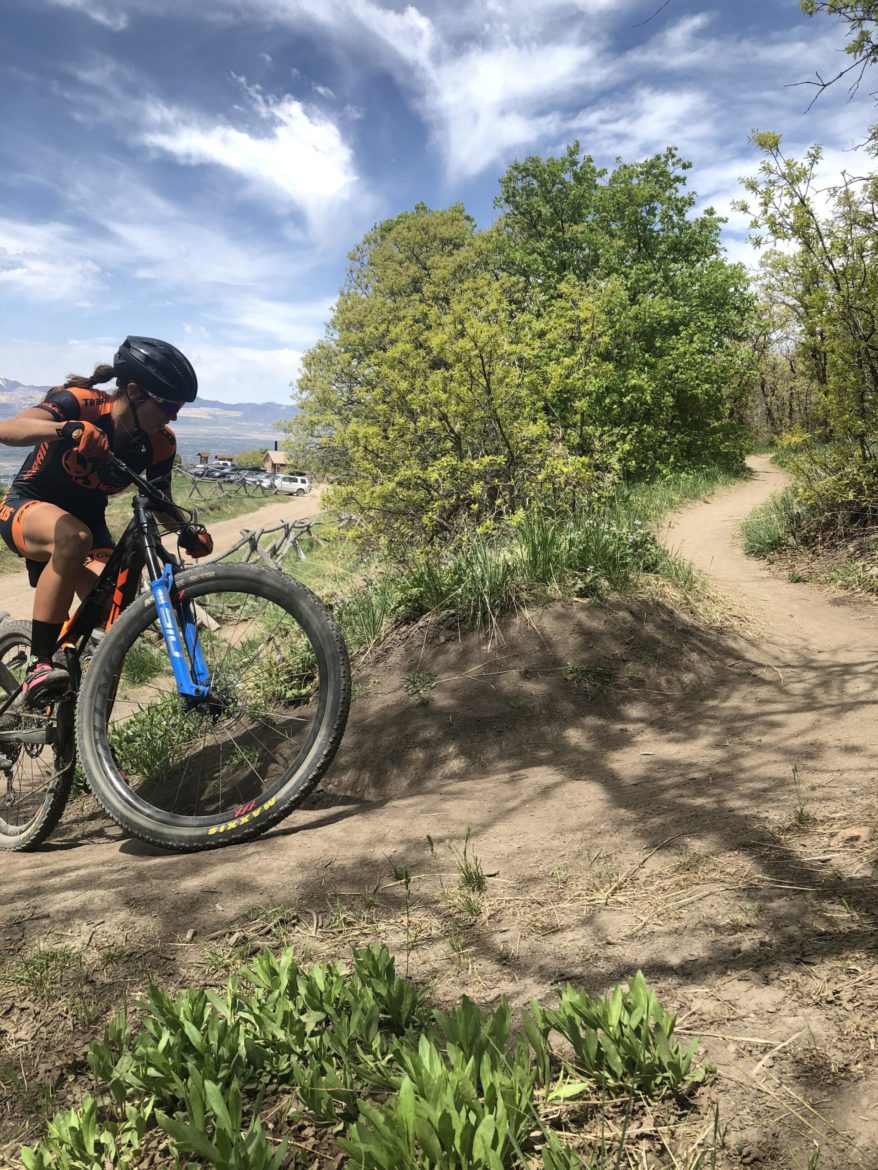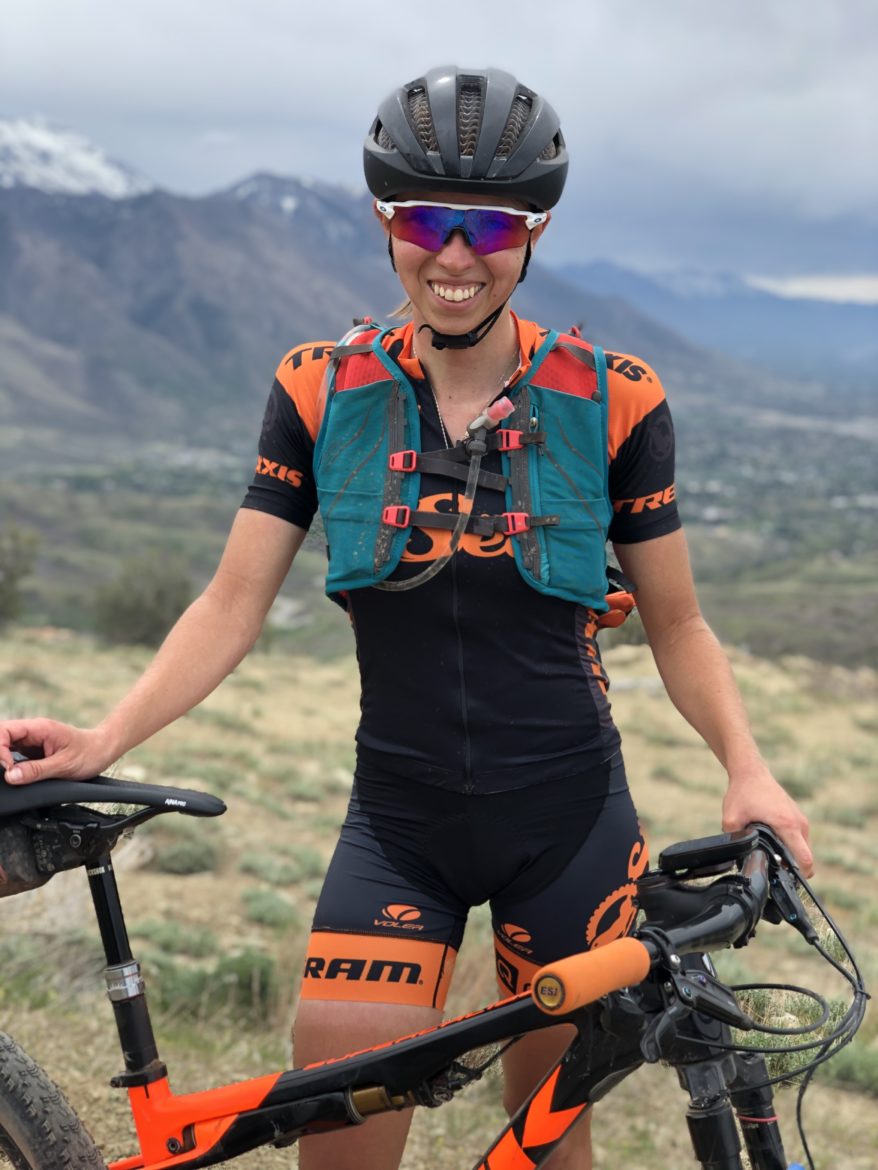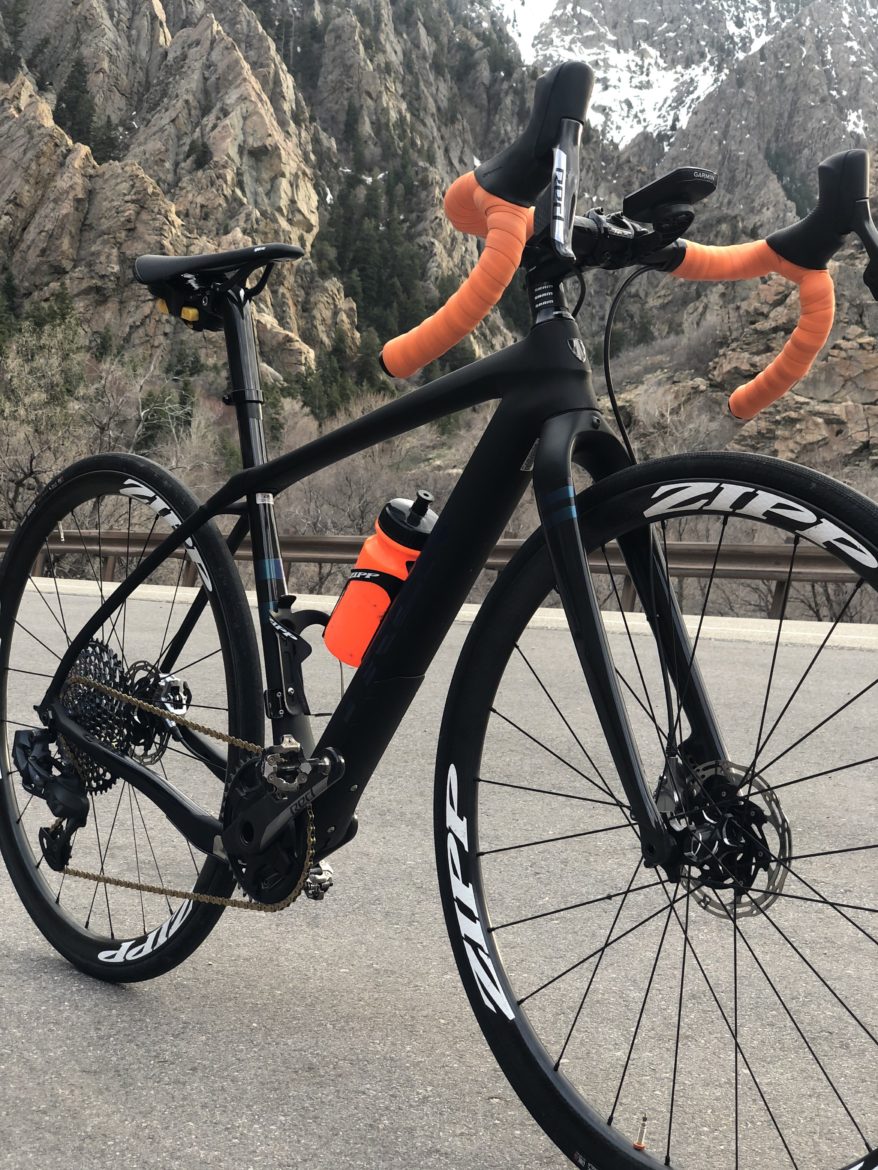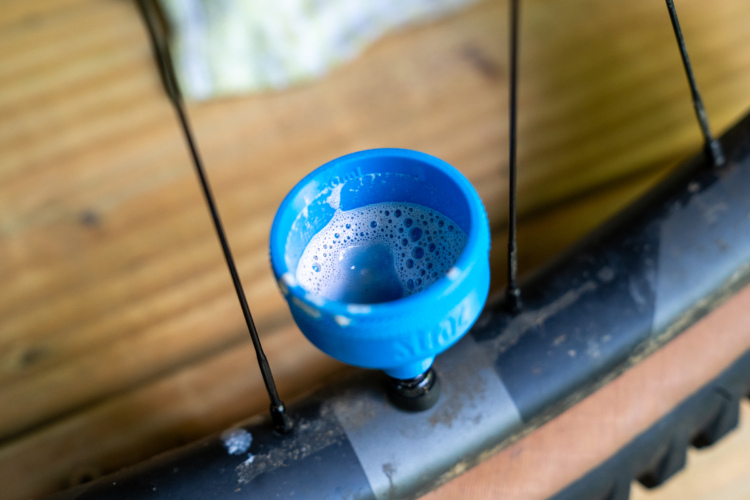
Some folks color the corners of their lives with bikes, while racers like Hannah Finchamp fill the whole screen. The five-time USA Cycling Collegiate National Champion also coaches fellow athletes and chose her current hometown of Salt Lake City for its ideal training conditions. She’s not messing around when it comes to speed and performance.
Finchamp lived in southern California before moving to St. Charles, Missouri at age 18, where she attended Lindenwood University. Her goal was to find a school with a solid swimming, bike racing, and track program. Having raced her first triathlon at just nine years of age, Finchamp’s priorities were well seated.
“By age 11 I was racing ITU Draft Legal Style races. I went on to compete in Escape from Alcatraz many times, compete for TEAM USA at the Junior PanAmerican Championship, and by age 17 win the Overall XTERRA Amateur Triathlon World Champion title two times.”
All of her focused academic and athletic requirements were met in one place, Missouri. “I swam and ran NCAA Division 2 and I rode for the Division 1 cycling team. I was also able to double major in Athletic Training and Exercise Science. I graduated in four years and moved to Salt Lake City, Utah where I now live. I truly believe it is the best place for me to grow and train as a professional cyclist.”
It wasn’t all about triathlons for Finchamp. She also dug into the dirt early on, both training for and racing XTERRA events. “My first mountain bike race was at ten years old in an effort to ‘train’ and ‘prepare’ for triathlon. I viewed mountain bike racing as a training tool all throughout high school. I raced the high school NICA league, but still viewed that as a great training opportunity. I did discover that I loved the mountain bike enough that I wanted to be able to continue to race it in college. I’m so glad that I did because when I turned 20 and was in college, I decided to turn my athletic endeavors entirely to the mountain bike.”
We had a nice chat with Finchamp about her racing career, and she shared some bonus tips on bike fit that we all can benefit from.

What’s something you learned or taught someone while on the Allstar Luna/Clif team?
Clif offered me a lot of opportunities throughout my career. They recruited me onto the team as a triathlete, and when they transitioned away from triathlon to focus entirely on a mountain bike, they gave me the option of attempting to transition with them. I decided to give it a go and they supported me as I had to work from the bottom back up.
As a young and relatively inexperienced mountain biker, my Olympian teammates often taught me by example and I spent a lot of time observing the way they would adapt to each scenario and rise to the occasion. In that same way, I felt a personal need to rise to the occasion and improve with each experience that I had. I grew tremendously throughout those seven years on Clif. Recently, Clif announced that they would no longer be racing internationally as a team and their focus would be on domestic races. With a growing career, and big international aspirations, it was time for me to move on.
Now that I am a part of the Orange Seal Off-Road Team I have the opportunity to write my own story and chase those international aspirations. As a team we work hard to capitalize on each individual’s strengths both on and off of the bike and I am very excited to reach new heights with their support.
How do you prepare your body the night before a bike race?
The night before a race, all of the hard work is done. I usually make sure that I have everything prepared ahead of time so that the evening before a race can just be focused around mental and physical rest. I will eat a good dinner, hydrate, put my legs up, and stretch. All of my equipment for the next day is laid out so that I don’t have to think the morning before the race.
What’s your favorite post-race snack?
Before I leave the finish chute, I always have my GU Chocolate Recovery Drink. It’s really important to consume protein after a hard effort so I try to get that in as soon as possible (plus it’s delicious and refreshing).
After that it constantly changes. After shorter efforts I am usually after something sweet like a chocolate chip cookie, but after longer efforts I usually pick what I dreamed up around hour five of the race. Despite famously eating a burger with my gloves still on in the finish chute at the Mid South gravel race, that is very rarely my go-to snack, but clearly it was exactly what I was dreaming of in that moment.
Are there significant ways that your experience as a professional female racer differs from your male peers?
I think that there are a lot of ways that the career of a professional female cyclist and a professional male cyclist differ. Our bodies and minds often function differently so the strengths and weaknesses of both genders will shine in unique ways.
From an equality standpoint, I am very lucky that women have paved the way ahead of me and have set a stage of growing equality. While there are still improvements to be made, I have been fortunate enough to experience growth and see more equal opportunities continue to come forth.
How long have you been coaching fellow athletes?
I graduated from college in 2018 with two degrees. One is in Athletic Training which is a healthcare profession and focuses on the prevention, diagnosis, and rehabilitation of injuries. My other degree is in Exercise Science which focuses on human performance and coaching. In addition, I am a USA Cycling Certified Coach and a Board Certified Athletic Trainer. This knowledge makes my coaching unique as I use science, personalization, and experience to craft training plans for each athlete that I work with. I have been coaching for three years now and have coached cyclists, triathletes, ironman athletes, marathoners, and more. I seek to use scientific knowledge to cater to the uniqueness of human performance and I work hard to be able to back my philosophy with research.

What’s something most people in your racing community don’t know about you?
Surprisingly enough, until recently, many people in the cycling community did not know that I started in the sport of triathlon. I did not grow up in a ‘racing’ family and I’m the only person in my family who competes in racing events.
Do you have a favorite story from traveling the world to race your bike?
I don’t have one favorite story from traveling the world. It’s incredibly hard to pick just one. Each and every scenario has a special place in my heart. That’s part of what I love about this sport is all of the crazy circumstances you encounter over the years and learning to overcome in each scenario.
I have unstacked and moved a tent in the middle of the night at the BC Bike Race in Canada, I raced a triathlon in South Africa, I’ve been to the hospital in Australia, I raced my bike in Europe for the first time in Andorra, and I’ve chased UCI points in Spain. The list goes on and on. I think any bike racer would tell you that sometimes the hardest situations and the happiest celebrations can both make for the best memories.
What has changed about your 2020 season thus far, and what is the future looking like for you?
My first race of 2020 was the Mid South Gravel Race in Stillwater, Oklahoma where I rode away with the win. Shortly thereafter, racing across the world was put on pause as we all try to fight this unprecedented virus together.
Like all cyclists, my racing calendar has been drastically cut down. I would say that at least 75% of my races have been cancelled and the remaining 25% are either indefinitely postponed or surrounded by uncertainty. As someone who likes to plan and is extremely detail-oriented, it is challenging to not know exactly what the future holds or when we will race again.
I love training though and I love riding my bike. I am able to ‘race myself’ and seek personal improvements each day in training. I am using this time to make improvements and hone by craft even further so that when it is time to race again, I will be more ready than ever. I’m not sure when it will be safe to line up again but I am hopeful for some fall mountain bike and gravel races as well as the UCI World Cup schedule.
Some of Finchamp’s top results
- 2x XTERRA Overall Amateur World Champion
- 5x Collegiate Cycling Individual National Champion
- MidSouth Gravel Race Winner
- Top 5 Elite XC National Championship
Bike fit tips
Hannah says, “I would like to make it clear that I am not a fit expert, nor do I have any certifications related to bike fitting, but I have a lot of experience and am speaking based on that personal experience and my extensive knowledge of the human body in general.”
How often do you get fit to your bike?
I get a bike fit every time I get a new bike. Each bike make and model is slightly different and while you can match your fit very closely with measurements, I think it’s extremely valuable to have an expert analyze your position in person.
Do you typically adjust your fit due to pain or to improve performance?
Both! If you are in pain then you probably won’t be performing optimally so a fit adjustment that is made to address pain will probably also improve performance.
What’s different between the fit for your XC and gravel bike? Do you keep any element the same across bikes?
I actually try to keep a lot of the elements the same because I switch between the two bikes very frequently and the more I can keep my body in one comfortable and optimized position the better. For example, my saddle height to bar height is very similar on both bikes and I also run the same shoes, pedals, and cleat positions between the two.
A mountain bike and a gravel bike are very different, however, so there will be some differences regardless.
The main difference is that I run my saddle slightly lower on my mountain bike. This is not uncommon. The main reason for this is because on the mountain bike, due to variety in terrain, you are moving a lot more on the saddle and the ever so slightly lower height gives you a little extra room. On the gravel bike, you will remain seated and in one position for extended periods of time so it makes sense to have the saddle in a different position.
Another difference is that my reach is much longer on my gravel bike. The stem is also much longer because handling is not as emphasized as [it is] on the mountain bike. A longer reach will also create a more aggressive riding and racing position.
As seat tubes continue to tilt steeper, does that affect bike fit? Should it?
The most important thing is that your saddle is in the same position over the bottom bracket. You can measure that with a plumb line. As seat tubes tilt steeper you might find that you have to push your saddle further back in order to find that same position. If you are putting in longer days on the bike, finding that ideal position will be important to prevent injuries and extra strain on your knees.
What are some things you have had to change about your fit with longer reach measurements?
I’ve started running shorter stems which has also helped me a lot with bike handling. As bikes are growing in length, I find that the reach measurement is the biggest determining factor as to what size bike I will run. For example, I’m on the 15.5 Supercaliber frame and the 17.5 Procaliber frame because of the reach differences.
Bike Check
Trek Supercaliber 29 (15.5)
- RockShox Sid Ultimate Fork
- SRAM Level Ultimate Brakes
- SRAM XX1 Axs ETap Drivetrain
- SRAM XX1 Quarq Powermeter
- Bontrager XXX Carbon Bar and Seatpost
- Bontrager XXX Carbon Wheels
- Maxxis Tires
- Orange Seal Sealant
- Bontrager Ajna Pro Saddle
- Esi Grips
Trek Checkpoint (49 cm):
- SRAM Red AXS 1x
- Quarq D-Zero Power Meter
- SRAM XX1 Eagle Cassette
- Zipp Bar and Stem
- Zipp 202 Wheels
- Maxxis Tires with Orange Seal Sealant
- Bontrager Ajna Pro Saddle
- ESI Bar Tape
What tires and pressure do you run in a dry race vs wet?
Tires and pressure are extremely important and personal game-time decisions. Tires are one of the only adjustments that I will make on race day depending on the conditions. The tire I pick depends not only on whether or not the course is dry or wet, but also what type of mud we are facing, if there are slippery rock faces, or other defining features.
In general, on the mountain bike, a Maxxis Aspen would be my go-to dry race tire and on the other end of the spectrum I would reach for a Maxxis Forekaster in the muddiest of scenarios. The main things I’m looking for are rolling resistance, the size of the lugs, and mud clearing ability. Those same concepts can be applied to gravel tires as well.
I keep my tire pressure fairly consistent, but on a fast and smooth track I might run as high as 20-21psi or as low as 18-19psi on the mountain bike. No matter what the conditions or what tire pressure I am running, I always have Orange Seal in my tires.
We wish Hannah Finchamp all the best with the coming season. Look for future articles with the Orange Seal team rider, where she will cover a variety of intriguing topics.















1 Comments
Jul 9, 2020